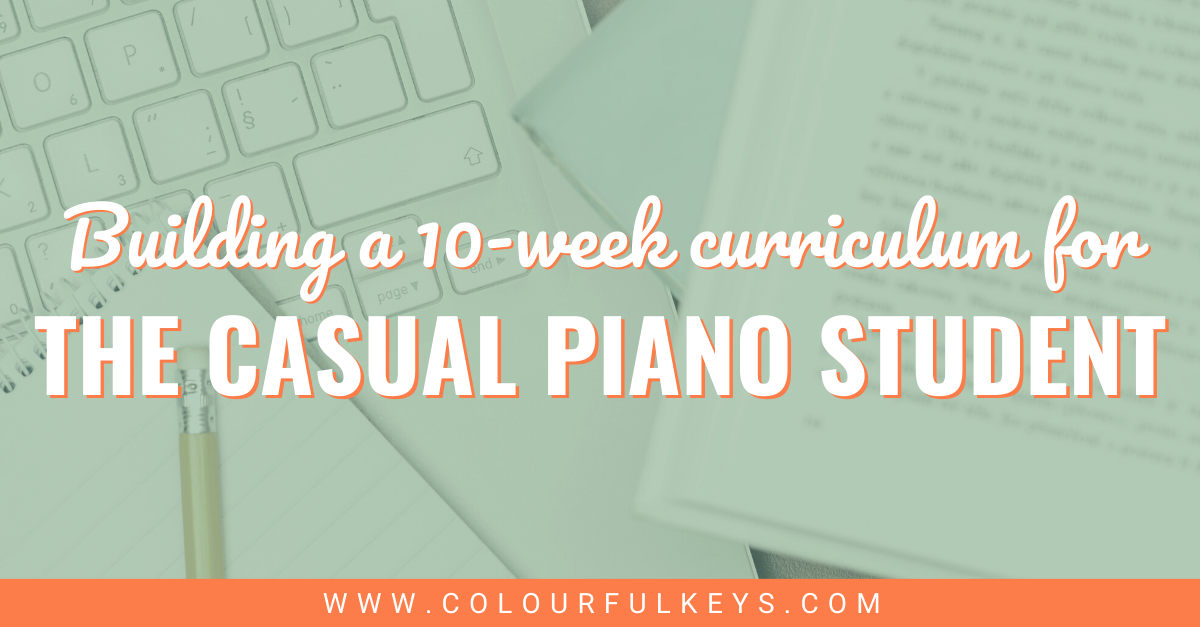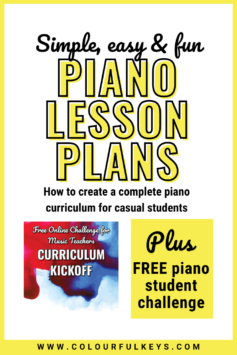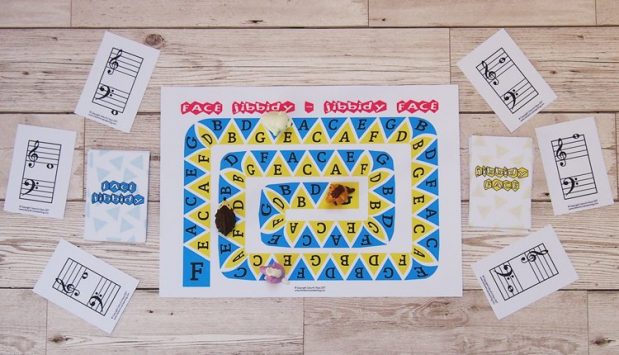
This article about teaching casual piano students was written by Carmen Carpenter. Carmen has taught music in a school setting as well as in her home studio for almost 30 years. Teaching combines two of her favourite things: music and kids! Besides teaching music, Carmen loves spending time with family playing games, working puzzles and watching movies. She’s also an avid reader and loves taking long walks on her local, woodsy trails.
I imagine many teachers have had a parent contact you proclaiming, “We just want little Tommy to give piano a try”. (I can feel your eye-roll through the screen right now. 🙄)
The more activities kids become involved in, the more I think it’s worth having a conversation about the casual piano student.

Before you stop reading because you would never take on a student like this, please hear me out.
Most piano teachers assume that every student who comes to them is going to be a lifelong piano player – at least, that’s the cherished hope, right?
But what do you do when a parent tells you they just want their kid to give the piano a try?
It is possible to teach the type of piano student I like to call “Tommy the Toe-Dipper”. With some creative scheduling and skill streamlining, you can take on the piano toe-dipper.
What’s a casual piano student?
When my son was young, he tried every sport: soccer, baseball, football, karate, wrestling and swimming. You name it, he probably tried it. As his mum, I wanted him to find his “thing”. As a music teacher-parent, I absolutely insisted he tried music, too.
I briefly gave my son piano lessons – until he announced that he didn’t really want to learn to play the piano. What a stab to the heart!💔
Many of us teach students like my son. These are kids who play one, two, or even three sports throughout the year. (Maybe even all at the same time!) They are often active in dance or musical theatre, too. Violin, trumpet or guitar might be among their pursuits as well.
These highly involved children have well-meaning parents who want them to try all the things believing it will help them find their thing. I call these students “toe-dippers” since they’re just testing out the waters of piano lessons.

Nicola’s Planning Lessons hub page is chock full of teaching goodness…when you’ve finished reading this article, hop over there to check it out!
But First…Know Thy Piano-Teacher Self
Knowing who you are as a teacher will help determine if taking on the toe-dipping piano student is a good move for you. Find out what makes you tick as a teacher by asking questions like:
- What motivates and inspires you to teach?
- Do you have an end goal in mind for your students?
Answering questions like these will be helpful as you consider taking on Tommy-the-Toe-Dipper as a student. But if you need a little more decision-making guidance, how about the ol’ Pros and Cons List?
Pros and Cons of Teaching Casual Piano Students
If you’re still not sure you want to teach this type of student, consider the pros and cons. Here’s my personal list of pros and cons:
Pros
- Piano can be a launchpad for further musical learning. Many parents tell their child they must first learn to play piano before another instrument like guitar or drums.
- The fun they have and your amazing teaching may convince them they need more, so you just might gain a new long-term student.
- Depending on how you structure your schedule, casual students could be a source of extra income.
- Even if this student doesn’t last, you may gain a positive referral, leading to a new committed student.
Cons
- If this is a situation where the parents are making Tommy try piano, the child may have a bad attitude.
- The toe-dipper family may have a subpar instrument for home practice.
- Tommy the Toe-Dipper will take space on your roster that a more committed student could fill. (But I have some ideas on that, so keep reading. 😉)
- If their heart isn’t in it, these students may not practise very much. This results in slow progress, meaning frustration for them and you.
How to Create Space in Your Schedule
Now that you think you may want to teach Tommy-the-Toe-Dipper (because you’re thinking about it, right?), you’ll need to consider how to actually fit these casual piano students into your schedule.

Well, actually, it’s not so much fitting them in, as it is creating a whole new space for them. You don’t want the toe-dipping student to take spots away from the more committed students in your regular teaching schedule.
How about creating a short-term package of lessons targeted to the toe-dipper student? This package could be 4, 6, or 10 lessons, all depending on what and how much content you plan to include.
Even if your weekly student roster is jam-packed, you may be willing and able to carve out an hour on a Saturday morning or a Sunday afternoon. You could do these lessons as a summer camp when your other students are on break, or even dedicate one evening every week, if you so desire.
It all depends on how full your roster is, and how much you want to bring those casual piano students into the permanent world of music-making.
If your toe-dipper decides they want to continue, you could move them to a regular weekly spot in your schedule and fill the “casual” spot with another toe-dipper.
What should casual piano students learn?
You’ve made it this far, so now it’s time to decide what to teach Tommy-the-Toe-Dipper. You may not have this student for long, so streamlining is crucial.
If you’re trying to teach piano essentials to a short-term student, I would stick to the most basic information they’ll need for piano playing. Think of it this way: If you only had 10 weeks to teach a student to play the piano for the rest of their life, what skills would you teach them?
The “Curriculum Kickoff” challenge is a great starting point for developing your own curriculum, whether it’s for 10-week toe-dippers or 3-year programs. Enter your info below and I’ll send the challenge info straight over!

Subscribe to the newsletter and get the Curriculum Kickoff challenge
Enter your details to subscribe to the newsletter for piano teachers with information, tips and offers.
I hate spam as much as you do! I will only send you emails related directly to piano teaching and you can unsubscribe at any time.
Psst: If you’re a member of VMT, you can access the 5-day step-by-step challenge in the training library.
10-Week Curriculum for Casual Piano Students
Here are the skills I’d include in a 10-week lesson package for an average 11-year-old Tommy-the-Toe-Dipper.
Keyboard Geography
This includes:
- High and low notes
- Moving up and moving down
- Patterns of black key groups
- CDE and FGAB key groups
No matter the age of your student, games are almost always the fastest way for students to learn these concepts and have them really “stick.” I especially love Letterama and Key Clamber from the Vibrant Music Teaching Library.
Not a VMT member? Wow, you sure are missing out! Learn more at vibrantmusicteaching.com.
Note Values and Counting Rhythm
I prefer to use rhythm syllables for casual piano students, but you can certainly use metric counting if that’s your jam. In 10 weeks, I would look to cover the following:
- Semibreves (whole notes)
- Minims (half notes)
- Crochets (quarter notes)
- Quavers (eighth notes)
- All associated rests
- 4/4 and 3/4 meters
Reading Notes on the Staff
With such a short time frame, don’t expect casual piano students to learn all the notes on the grand staff. It’s better to approach it with landmark notes coupled with intervallic reading.
I personally like to stick with 5 landmark notes and intervals of a 2nd and 3rd, then introduce the skips alphabet using games like FACEjibbidy-jibbidyFACE or Alpha.
Chords
If you teach students how to play chords from lead sheets or chord charts, they’ll be able to play the piano anytime, anywhere, for the rest of their lives.
The Pieces
Last but definitely not least, introduce repertoire that the casual piano student will love playing.
These students are older, and they want to play big-sounding pieces to impress their friends, so rote teaching is the way to go. Wait to introduce the music until they have a firm handle on the patterns.
Try some of the rote pieces from Piano Safari Older Student Level 1, or Samantha Coates’ BlitzBooks Rote Repertoire.
If you’re a member of Vibrant Music Teaching, remember to use your members-only discount codes for Piano Safari and BlitzBooks Rote Repertoire!
Final Considerations
In addition to scheduling and content, I’d consider a few other general matters.
How old is your toe-dipper?
Decide on the youngest age you would take on this type of student, and stick with your guns.
I personally wouldn’t take on a casual piano student younger than 9 years old. My own 10-week curriculum moves too quickly for anyone younger than that to make meaningful progress, and without progress, they won’t be motivated to continue lessons after the initial trial period.
Keep Your Piano Studio Professional (You’re Still Running a Business)
Have a strict up-front, payment in full, no make-up lesson, no refund policy for these folks. That way, if Tommy-the-Toe-Dipper decides the piano isn’t for him just 2 weeks in, you’ve still made money.
So the next time a parent tells you their child is simply trying piano lessons, you can tell them about the camp, workshop or lesson package you’ve designed just for their little toe-dipper.

Would you take on Tommy-the-Piano-Toe-Dipper?
I’d love to hear your thoughts in the comments below about taking on students who are “just trying” piano lessons. 🙂
